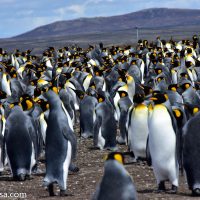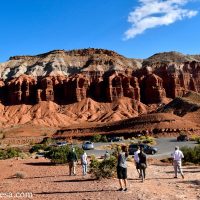One thing is certain at least for some of us: when you venture into America’s past by visiting Colonial Williamsburg, Jamestown, and Yorktown, what they taught you in grade school about American history is not only a simplified gloss-over of the subject, but in many cases is just plain wrong. While it’s important to see America’s wonders in the southwest, like the Grand Canyon and all the other magnificent parks and forests, it’s at least as important to visit the places where our country started; to see what happened not so long ago that caused this country to be born, and what the circumstances were that allowed her to prosper.
One place that should be on everyone’s “American Adventure” list is Colonial Williamsburg. Operated by The Colonial Williamsburg Foundation, this destination location is not only a historical lesson, but a resort destination for everyone. There are no thrill rides that tumble and throw people into the air, but there’s a certain thrill in walking down Willimsburg’s main street, seeing the people in costume and talking with people in full Williamsburg character; realizing that you could have actually lived here.
While this colonial city contained British loyalists, rebels and supporters of independence, slaves, and indentured servants, there was a purpose to this community, and even then the people involved must have known how important their choices and actions would be.

In Colonial Williamsburg, you can enjoy a carriage ride around town; much like it was in the 18th century. Photo by Donald Fink
When you think of Williamsburg, your context is probably its involvement with the American Revolutionary War. While the people of Williamsburg were certainly involved, they also represented an extremely successful colonial city. There were trades people working in all the trades necessary to make life in the “Colonies” as sophisticated as anywhere in the world, and the present day Colonial Williamsburg does a complete job depicting American life in this era.
Williamsburg was originally named Middle Plantation, and was established in 1632 (or 1638 depending on which account you read) as a fortification and place of safety for settlers along the York River, on the northern border of the Virginia Peninsula. The location of Middle Plantation was half way between Jamestown, the established location and capitol of the Virginia Colony, and the area of settlement.
The College of William and Mary – In 1693, the College of William and Mary was established by Royal Charter from King William III and Queen Mary II in Middle Plantation, and is currently the second oldest institution of higher learning in America. While contributing significantly to the popularity of Williamsburg, this College was also responsible for educating many of America’s forefathers, including Thomas Jefferson, James Monroe, John Tyler, and sixteen signers of the Declaration of Independence. George Washington received his Surveyor’s Certificate at William and Mary too. In 1779 the College became a University, and claims to be the first University in America. It has been in continuous operation since its beginning except for two occasions. It closed once during the American Civil War due to declining enrollment, and once between 1882 and 1886 due to financial hardships.
In 1976, a campaign debate was hosted between presidential candidates Gerald Ford and Jimmy Carter, and in 1983 a G7 summit conference was held on the campus.
Government Relocates to Middle Plantation – In 1676, during Bacon’s Rebellion at Jamestown, the House of Burgess (capitol building) was burned and the Virginia government was temporarily relocated to Williamsburg. Later, after rebuilding the House of Burgess in Jamestown, another accidental fire again burned the building, and the Virginia Capitol was relocated – permanently this time- to Middle Plantation. The College of William and Mary provided temporary housing while a permanent government building was constructed, and the town was formally named Williamsburg during the relocation in 1699 to honor King William III.

This original building served as the courthouse for the James City County Court and the Williamsburg municipal court. Photo by Donald Fink
American Revolutionary War – Many of the decisions that led to the American Revolutionary War against England were formulated in Williamsburg. In 1775, the Royal Governor, Lord Dunmore, fearing a rebellion, seized the gunpowder stored in the Williamsburg Armory. While threatening to destroy the city if attacked, Lord Dunmore and the citizens, led by Patrick Henry, arrived at a payment schedule for the gunpowder. Still, this incident was an important part of the circumstances that led to the Declaration of Independence from Britain, and ultimately war.
During the Revolutionary War, in 1780, the capital of Virginia was moved to Richmond because Virginia Governor Thomas Jefferson believed that Williamsburg was less secure and more vulnerable to attack. While Williamsburg suffered in terms of loss of business due to government activities, it did continue because of the College of William and Mary.
Williamsburg Revived – As time went on, Williamsburg settled into the role as a sleepy college town, and not much activity occurred compared to its early beginnings as a dynamic, fast moving revolutionary capitol city. Early in the twentieth century, the local Episcopalian Church in Williamsburg was in danger of falling into disrepair. Fearing the loss of a significant historical structure, the Rev Dr. W.A.R. Goodwin set out to restore this building. Having succeeded by 1907, he accepted a transfer to New York. Upon returning in 1923, he was alarmed to discover that most of the rest of the original Williamsburg was also falling down.

Many trades are represented by the various craftsmen that volunteer their time at Colonial Williamsburg. Here a carpenter is making furniture. Photo by Donald Fink
Dr. Goodwin sought financial assistance, and found it with John D. Rockefeller Jr and his wife, Abby. Together, they formed an organization that restored much of the original Williamsburg, and created the largest living museum in America. Today, the original Williamsburg is known as Colonial Williamsburg and is the largest teaching and entertaining tourist attraction in Virginia. The Colonial Williamsburg Foundation has done a remarkable job preserving this important historical location. While Dr. Goodwin had the original idea of preserving this part our American heritage, and Mr. Rockefeller provided much of the financial support and a significant portion of the original management of the project, the Colonial Williamsburg Foundation has been able to keep up with the changing times, bringing our history to all who will listen. They have continued to preserve and expand Colonial Williamsburg including many interpretive and outreach programs for visitors and schools.
What to do here: Williamsburg is not a complete travel destination by itself, but is certainly worthy of a full day, or even a few days. Another place that shouldn’t escape your plans is Historic Jamestowne. This place is fascinating for many reasons, and certainly deserves a visit. It could easily take a full day to see this great exhibit. There are actually two exhibits at Jamestowne: the fort depicting where the setters lived and worked, and the Indian Village, depicting a typical Indian settlement. Neither are the actual locations, but are very believable representations of actual settlements.
If you end up in Williamsburg, and get to a point where you just can’t take in any more stuffy ol’ American History, you may need a visit to Busch Gardens. Take it from one who lives less than 10 minutes from Disney World, nothing brightens up your outlook more than a day at an amusement park.

Defense was a big part of life in Colonial Williamsburg. Infantry barriers could be put in place quickly to slow the advance of an enemy. Photo by Donald Fink
Take a look at the web site for the town of Williamsburg. There you’ll find several more places to visit and activities in the area from museums, to plantations, even a Ripley’s museum. There’ll be something there for everyone in the family.
There are a couple of good web sites to visit to get better information about Yorktown. The first is the Jamestown Settlement and Yorktown Victory Center, and the second is Historic Yorktown, from the National Park Service. Located just thirteen miles from Williamsburg along the York River, this historical site is import for a number of reasons. While it was an important seaport for exporting tobacco, it is probably best know as the location of the last significant battle of the American Revolutionary War, where the Patriots, aided by French and Canadian troops defeated the British during the Siege of 1781. You can read a brief description of the Battle of Yorktown here on our site.










